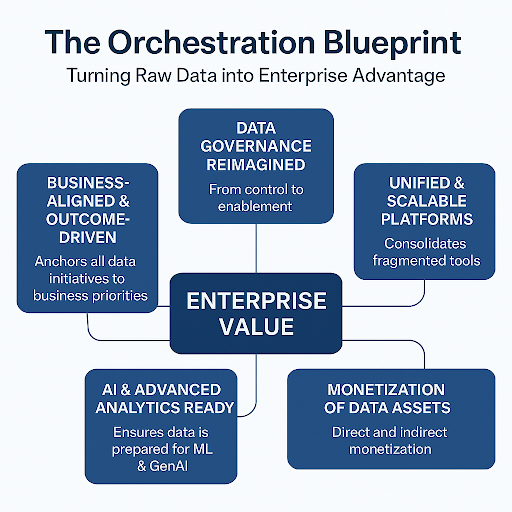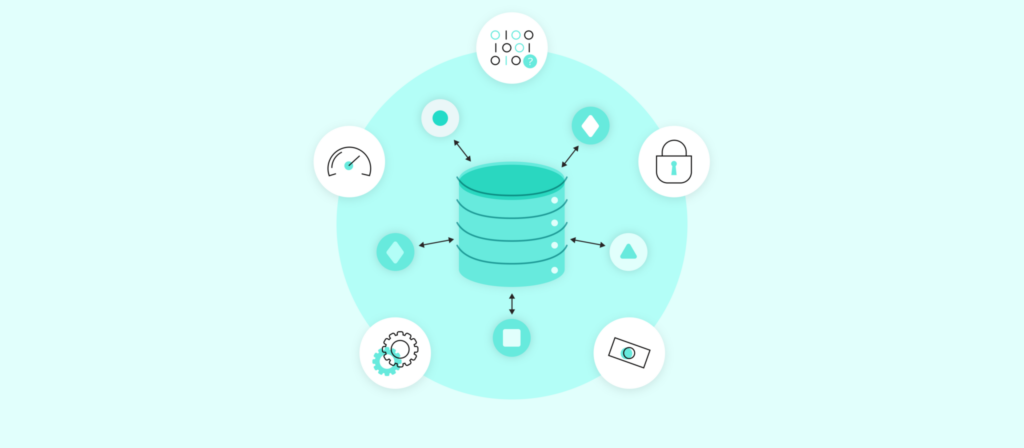It’s often said that “data is the new oil” — valuable, but only once refined — and that “data is the new gold” — rare, precious, and immensely valuable when mined and shaped. A modern enterprise data strategy embraces both truths: raw data in isolation has limited utility, but when governed, contextualized, and orchestrated, it becomes a strategic asset that fuels AI adoption, digital transformation, and entirely new revenue streams.
The challenge? Most organizations are swimming in data but lack the orchestration blueprint to transform it from operational exhaust into enterprise advantage. Today’s leaders need more than technology—they need a strategy that blends governance, business alignment, and scalable platforms into a unified approach.

Below, we explore the five pillars of a modern enterprise data strategy, with real-world examples of how leaders are putting them into practice.

1. Business-Aligned & Outcome-Driven
Too often, data projects stall because they’re treated as technology-first initiatives rather than business programs. A modern strategy flips this approach:
- Salesforce pioneered customer-centric analytics by aligning data initiatives directly to revenue impact, enabling sales teams to prioritize accounts based on predictive churn and upsell signals.
- A global retailer used Workato to orchestrate supply chain data across ERP and logistics systems, reducing delivery delays by 15% and improving customer satisfaction scores.
The lesson: data projects must be framed not as IT tasks but as enterprise-wide initiatives tied to measurable outcomes.
2. Data Governance Reimagined
Governance has long been viewed as restrictive—focused on compliance and control. But in the modern era, governance is an enabler:
- Capital One adopted a federated data ownership model inspired by Data Mesh, empowering business units to manage their own data products while aligning to enterprise security standards.
- With Workato, companies establish governance guardrails by ensuring all agent-to-system interactions are routed through secure proxies with full audit trails—enabling trust while maintaining agility.
Here, governance shifts from “policing data” to unlocking safe, responsible access at scale.
3. Unified & Scalable Platforms
Fragmentation is the enemy of speed. A unified strategy consolidates the data ecosystem:
- Snowflake enables organizations to consolidate data into a single, cloud-native platform, while still supporting multiple workloads (batch, real-time, and ML training).
- Workato complements this by unifying not just the data warehouse but the surrounding automation fabric, breaking down silos between SaaS apps, APIs, and on-prem systems.
The outcome: a scalable, adaptable platform where both data engineers and business users can drive innovation.
4. AI & Advanced Analytics Ready
Artificial Intelligence is only as powerful as the data feeding it. Organizations that prepare and orchestrate their data for AI are seeing outsized returns:
- Databricks customers leverage unified analytics platforms to fuel ML pipelines that predict equipment failures before they happen, saving millions in downtime.
- Enterprises using Workato’s orchestration with LLMs can embed AI directly into workflows—for example, enabling customer support agents to retrieve the last 5 Zendesk tickets with context-aware AI summaries, without ever leaving their workflow.
This is where predictive, prescriptive, and generative intelligence moves from the lab into business-critical operations.
5. Monetization of Data Assets
The most forward-looking enterprises are turning data into revenue:
- Airbnb monetizes its data by optimizing pricing in real time, dynamically adjusting based on demand signals.
- Stripe has turned data into APIs—providing partners with fraud detection services powered by transaction data.
- Workato customers increasingly expose their data pipelines as APIs—transforming internal integrations into externally consumable data products.
Whether direct or indirect, monetization turns data from an IT expense into a profit center.
The Future: Data as Fuel and Currency
A modern enterprise data strategy is more than a technology roadmap—it’s a business-first, governance-enabled, AI-ready framework. It transforms:
- “Data as the new oil” → refined fuel for automation, orchestration, and real-time decisioning.
- “Data as the new gold” → measurable business value, from trusted insights to new revenue streams.
The orchestration blueprint isn’t just about managing data—it’s about unlocking its potential to power innovation, scale AI responsibly, and future-proof the enterprise. Learn more about Workato’s Data Orchestration solutions today.
